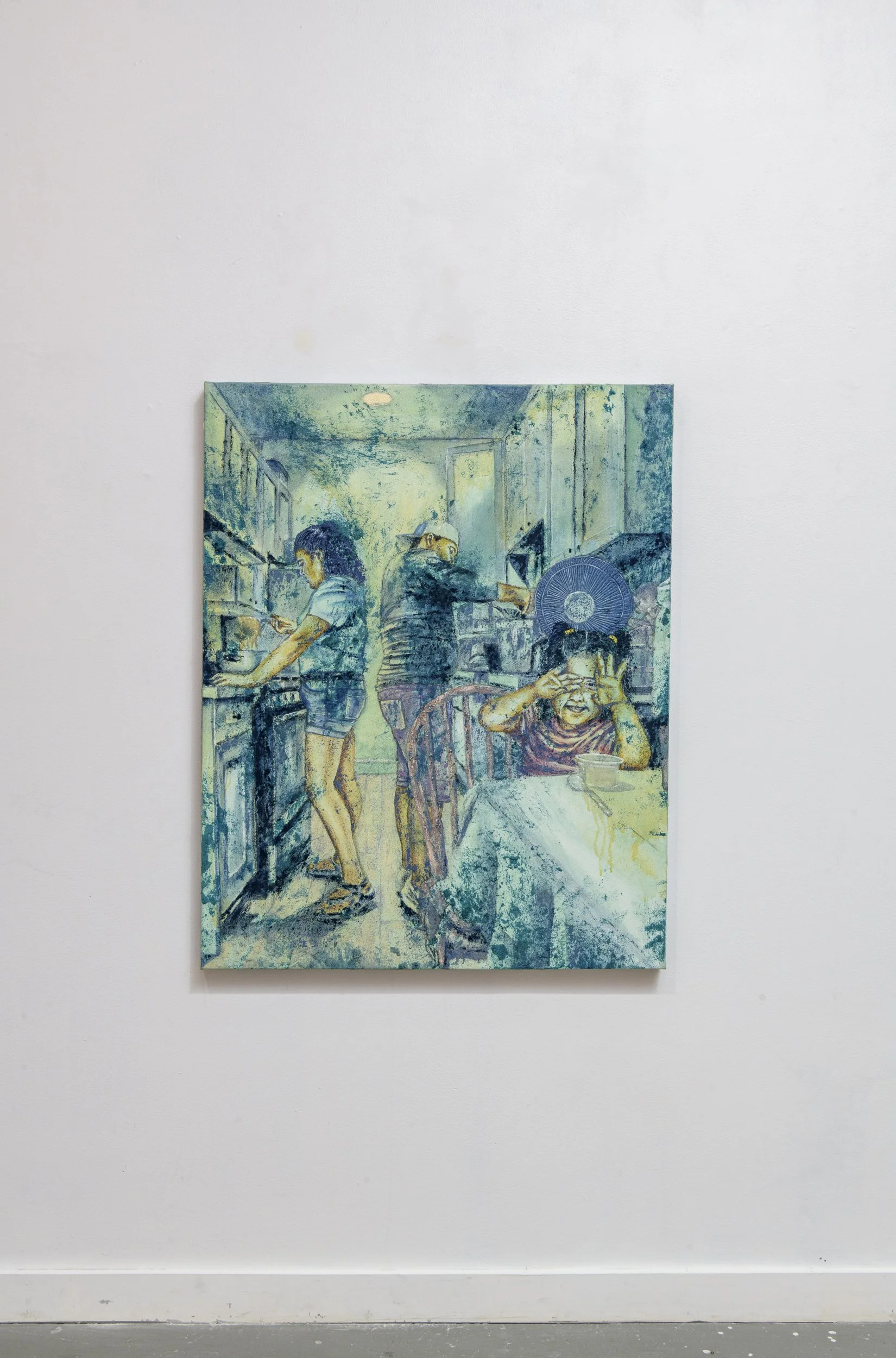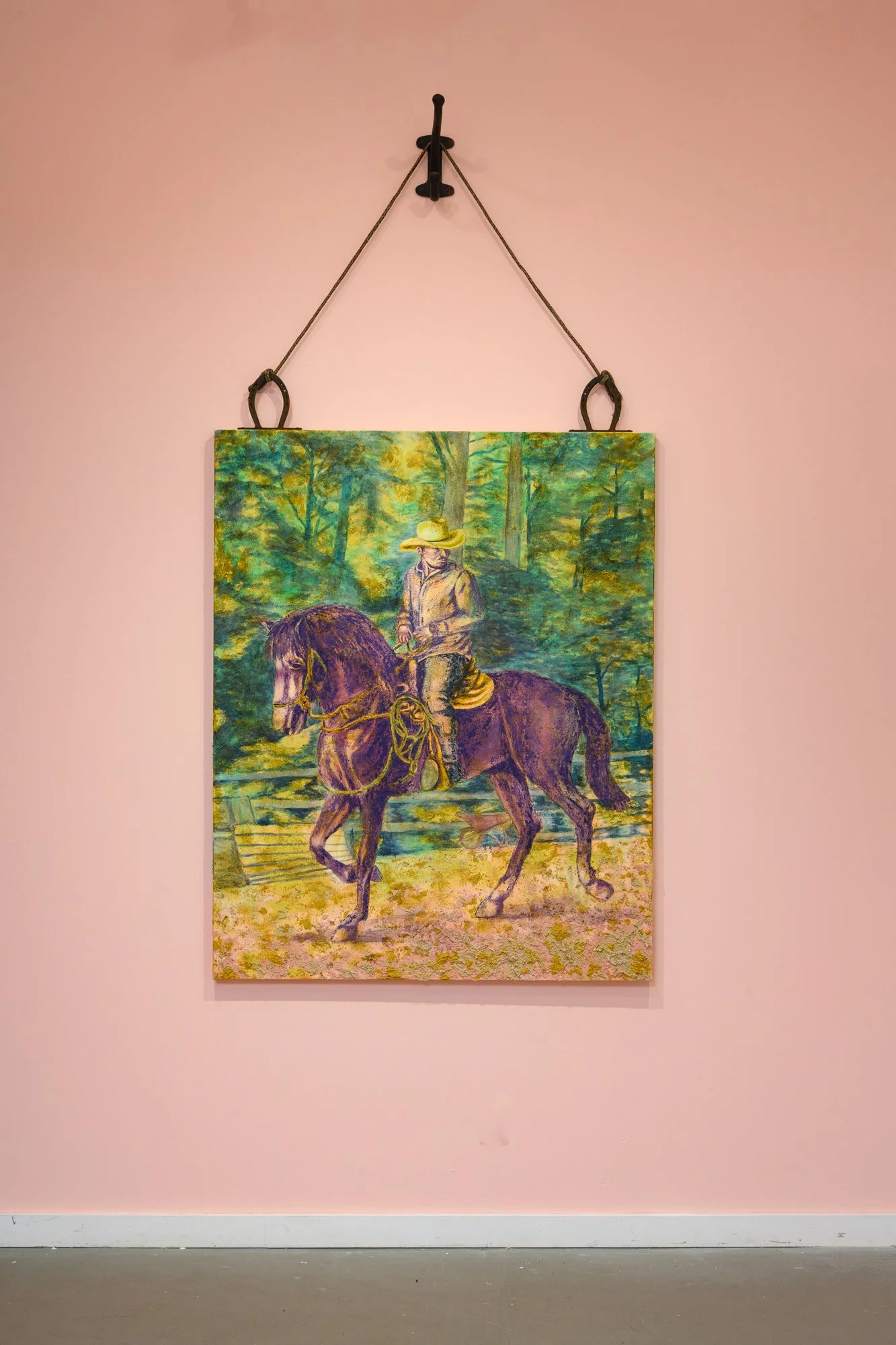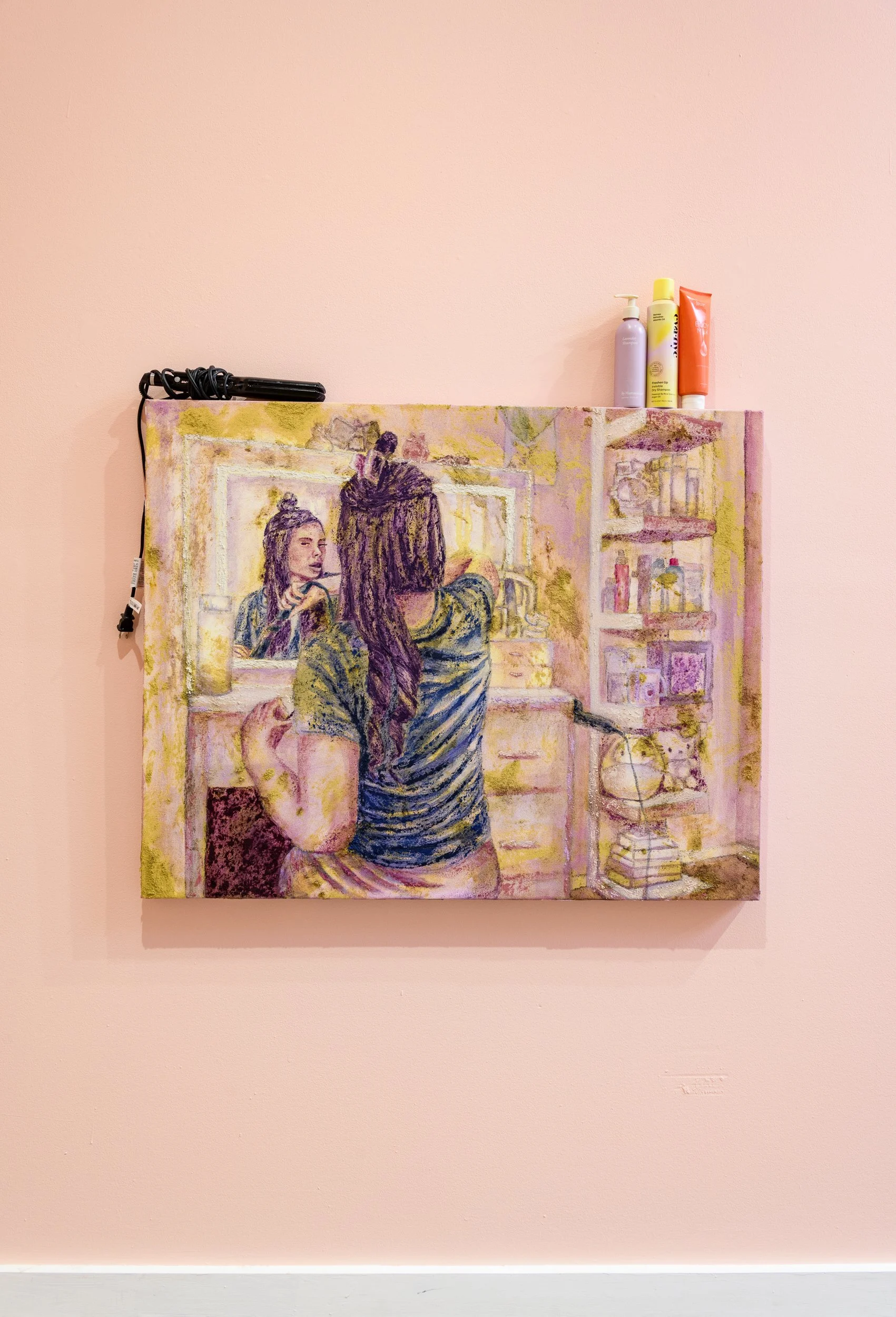Henry Morales: Care as Citizenship
A young girl smiles at the viewer, her face partially concealed by open hands. She sits at a table with a bowl and spoon before her. In the background, a woman and man (the girl’s parents) stand back-to-back in their galley-style kitchen. They are cooking a meal, intently focused on a particular element of this collaborative endeavor. As the parents work to prepare food, their daughter laughs and enjoys herself, seemingly unaware of the work behind her. It is a pedestrian scene rendered in earthy blue undertones with lilac and cream accents on the skin and clothing of the portrayed subjects. Strategic impasto on certain details—the hair of the young girl and her mother, the oscillating fan in the background, the worn wooden chair on which the child sits—dimensionally extend the painting into the space of the viewer.
This is Henry Morales’s Peekaboo, one of 10 new paintings in the series Los de Aquí, currently on view at Tiger Strikes Asteroid Philadelphia. Morales’s series title reformulates the common phrase “Ni de aquí, ni de allá” (“from neither here nor there”) to rethink the placelessness of diasporic Latinx communities. In Morales’s case, this is personal. Morales’s parents and many of his extended family immigrated to the United States from Guatemala. Today, they are scattered across the United States.
In preparation for Los de Aquí, Morales traveled across the country to live with his cousins and document their daily lives. The photographs he captured during these travels became the subject material for this series.¹
Morales renders scenes from his travels in pastels and jewel tones, softened versions of the vibrant hues of the Indigenous Guatemalan textiles that he admires. This softening of the bright patterns and colors can be a formal metaphor for the geographic distance between Morales’s Guatemalan-American family and their ancestral home. Morales also uses monochromatic groupings to distinguish individual family units from one another. His works represent each family with a single predominant hue across the series, reinforcing their relationships to each other as central to their identities.
Throughout Morales’s travels, he discovered countless moments of intimacy, care, and affection. which sustains his family through their pursuits of the elusive American Dream. Peekaboo exemplifies this theme. The parents hard at work in the kitchen provide for their daughter, whose playful air indicates she is living a happy life, thanks to the dedication and sacrifices of her parents. It is a quiet moment brimming with histories of struggle, endurance, and a commitment to love. Other works show this dedication more obliquely: a father playing with his laughing son in the yard, a group of men laughing as they share a drink and take a selfie, a young child playing games on a phone. Each painting is a variation exploring how Latinx communities use care as a placemaking practice.
Morales’s material approach to his paintings affirm the performative power of care in this placemaking endeavor. Each painting is a composite of oil, pigment, and dirt from the homes of Morales’s relatives. Morales specifically lists among his materials, for example, “dirt from outside my Cousin’s Home in Las Vegas” for his painting O’Si Saben Como Me Pongo, Porque Me Invitan? [If y’all know how I get, why do y’all invite me?]. The use of possessive—“my Cousin” and “my Cousin’s home”—reinforce a sense of belonging. Morales acquired the dirt through his travels and maintains a meticulously organized collection of labeled dirt jars for future use. It is a hopeful belief that the “fleeting moments of authenticity” he portrays in the Los de Aquí series will inspire future moments of care for him to paint.
One of the largest and most commanding works in this series, entitled Amo Lo Que Hago [I Love What I Do], shows how this ethic of care extends beyond his relatives’ homes. This painting depicts Morales’s cousin on horseback, donning a cowboy hat and looking attentively over his left shoulder as he guides his horse around a paddock. It is a passing moment at his cousin’s equestrian dressage business, an otherwise uneventful scene. What matters is the history that went into this moment. Morales’s cousins distinguish themselves from business competitors by practicing ethical, animal-first training methods, many of which his family developed in Guatemala prior to their move to the United States. Through Amo Lo Que Hago, Morales shows how the impact of his family’s care—informed through an embrace of their Guatemalan heritage—resonates beyond the confines of family homes, transforming whole communities.
For some, the pastel-rendered quietude of Morales’s paintings may feel removed from the reality of many Latinx experiences in the contemporary moment. Immigrations & Customs Enforcement (ICE) abductions in Black and brown communities have grown more insidious in recent years. Forced deportations and detainments tear apart families not unlike the ones Morales paints. Latinx communities have gone so far as to cancel community events and celebrations for fear they will attract ICE agents and abductions. Cities like Chicago, Memphis, and Portland are under military occupation by the National Guard, deployed by the president of the United States to assist ICE with its campaign of persecution. In the face of such violence, Morales’s kitchen scenes, equestrians, and selfies make for a compelling choice of subject.
Morales presents these scenes as a radical counter to the oppressive tactics of ICE raids and other xenophobic, anti-Latinx agendas that inform contemporary U.S. social and political discourse. In Cruelty as Citizenship: How Migrant Suffering Sustains White Democracy, Cristina Beltrán argues that contemporary U.S. political rhetoric regarding citizenship and immigration maintains the colonial-era pursuit of a (white) racialized democracy (Herrenvolk democracy) reliant on “spectacles of racialized violence and cruelty.”²
In other words, the United States is founded on the principle of cruel exclusion of a racialized other to affirm a white citizenry and their claim of place. It is a self-serving model that presumes the necessity for racialized cruelty, almost exclusively against non-white communities. In the present moment, the Trump administration enacted this through punitive efforts to expel immigrants and Latinx communities from the United States. By criminalizing brownness and Latinidad, which recent Supreme Court decisions like Vasquez Perdomo v. Noem in effect have done, the current U.S. government fulfills the white supremacist, Herrenvolk democratic agendas ingrained in the founding principles of the nation.
Morales’s paintings counter the Herrenvolk premise that a homeland must be cruelly enforced in service of whiteness. He shows how you can make a lasting home through radical acts of love, dedication, and an embrace of brownness. In the face of violent political and social rhetoric, the joy and care exhibited by Morales’s relatives in Los de Aquí refutes the Herrenvolk mindset. Rather than subject themselves to the self-serving politics of white democracy, Morales’s family insists on caring for one another and providing care to all those whom they encounter. Through this commitment, even the quietest moment is a radical act of placemaking for Latinx communities in America. It is also a proposal for a different future: one where Herrenvolk does not dictate the law of the land and citizenship is instead predicated on our commitments to one another and the healing of divisions, racial or otherwise.
Morales invites us, the viewer, to engage with this vision through his integration of painting with the world beyond his work. In addition to Morales’s consistent use of impasto (which extends his paintings into the realm of the viewer), Morales displays his paintings alongside accoutrements that blur the line between artwork and reality. Viewers can sit in a kitchen chair to view Peekaboo, as if sharing the table with Morales’s cousins. Hair care products adorn the top of Getting Ready for my Birthday Dinner, which depicts Morales’s cousin curling her hair in the mirror. Amo Lo Que Hago features horseshoes and rope in homage to the subject’s occupation. By integrating his paintings into the world of the viewer, Morales materially invites us to join the family in enacting care for ourselves, each other, and the world.
With this invitation, Morales gives us a charge to confront the violence of anti-Latinx politics wreaking havoc across the United States. Around the sides of his paintings, Morales pastes newspaper clippings detailing ICE raids, racial profilings, and other anti-immigrant acts of violence in the United States that occurred during the time Morales completed this series of paintings. As viewers engage closely with Morales’s work, they also bear witness to ongoing violence against Latinx communities across the United States. It is a quiet plea for viewers to enact the care and love Morales depicts in his paintings, and to advocate that others do the same.
Los de Aquí tells the story of another America, one in which affection and a commitment to one another define one’s status of belonging. In showing the placemaking power of care for Latinx communities, Morales offers a vision of a world transformed. He documents an already-unfolding future of Latinx joy and care, predicated on familial love, in the face of an ever-worsening national landscape. Morales asserts the precarity of Latinx family life, the very underpinning of this future of care, through his incorporation of anti-Latinx violence around the sides of his canvases. How might we, the viewers, embrace Latinx care and its alternative futures, support the placemaking aspirations of Latinx communities, and enact a similar ethic of care in our own lives? The answers to these questions might be the key to restructuring our worlds, political and social, into the welcoming places for which Latinx communities, among others, long.
¹ The only exception to this isWith the Homies, which Morales based on a photograph his cousin sent him.
² Beltrán, Cristina. Cruelty as Citizenship: How Migrant Suffering Sustains White Democracy. Forerunners: Ideas First (Minneapolis, MN: University of Minnesota Press, 2020), 104.
Los de Aquí exhibition is on view at Tiger Strikes Asteroid Philadelphia until Oct. 18, 2025.





